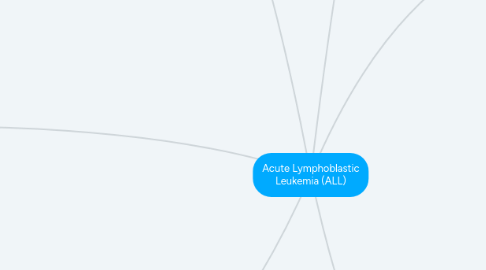
1. Pathophysiology
1.1. Progressive Neoplasm defined by the presence of greater than 30% lymphoblast in the bone marrow or blood
1.1.1. Children
1.1.1.1. Most cases are found in children
1.1.1.1.1. median age of 13 year old
1.1.2. Adults
1.1.2.1. less prevalent, but higher mortality rate
1.2. Transfromed precursor B cells and or T cells
1.2.1. Precursor B Cell ALL Different Phenotypes
1.2.1.1. Expresses CD19, Human leukocyte antigen DR
1.2.1.2. Other B-cell associated antigen in the cytoplasm
1.2.1.3. the most immature form of of precursor B- cell ALL lack the expression of CD10
1.2.1.3.1. CD10 (Common ALL antigen)
1.2.1.3.2. Seen in 5% of patients
1.2.1.4. Most Common Precurssor B Cell ALL epressess CD10 antigen
1.2.1.4.1. Seen in 80% of patients
1.2.1.4.2. Have not undergone rearrangement of Immunoglobulin genes
1.2.1.5. Strongly associated with aneuploidies
1.2.1.5.1. Philidelphia chromosome ALL carries the worst prognosis
1.2.1.6. Seen More commonly in children
1.2.2. Precursor T Cell ALL
1.2.2.1. Most common lymphoid marker
1.2.2.1.1. CD3
1.2.2.2. Other lymphoid makers used
1.2.2.2.1. CD7
1.2.2.2.2. CD12
1.2.2.2.3. CD5
1.2.2.3. Most common genetic alteration in T-Cell ALL
1.2.2.3.1. T-cell Receptor (TCR)
1.2.2.4. More commonly seen in adults than in children
2. Causes/Risk Factors
2.1. Specific causes are unknown
2.2. Prenatal exposure to radiation
2.3. Postnatal exposure to high dose radiation
2.4. Viral Infections
2.5. Higher incicences with genetic diseases
2.6. Prevention is almost impossible due to unknown cause
3. Diagnostic Test
3.1. Immunotyping
3.1.1. Leukemic blast cells
3.1.1.1. Children
3.1.1.1.1. Transformed precursor B-cells
3.1.1.2. Adults
3.1.1.2.1. Mixture of transformed precursor B and T cells
3.2. Blood Testing
3.2.1. Complete blood count
3.2.1.1. Elevated White blood count
3.2.1.2. Thrombocytopenia
3.3. Bone Marrow testing
3.3.1. Bone Marrow Biopsy
3.3.1.1. >25% bone marrow blast with or without mass lesion =Acute Lymphoblastic Leukemia
3.3.1.2. Less than 25% bone marrow involvement, with mass lesion= Precursor B Cell Lymphoblastic Lymphoma
3.4. Staining of peripheral blood
4. Common Findings
4.1. Amemia
4.1.1. Fatigue
4.2. Thrombocytopenia
4.2.1. Bleeding
4.2.1.1. Petechiae
4.2.1.2. Ecchymosis
4.2.1.3. Gingival bleeding
4.2.1.4. Hematuria
4.3. Fever
4.3.1. Infection
4.3.1.1. Oral cavity
4.3.1.2. Throat
4.3.1.3. Respiratory tract
4.3.1.4. Lower colon
4.3.1.5. Urinary tract
4.3.1.6. Skin
4.3.2. EARLIEST SIGN
4.4. Weight loss
4.4.1. Anorexia
4.4.1.1. Muscle atrophy
4.4.2. Decrease in sense of taste
4.4.3. Swallowing difficulties
4.5. Organ enlargement
4.5.1. Hepatomegaly
4.5.2. Spleenomegaly
4.5.3. Lymphadenomathy
4.6. Pain
4.6.1. Bone pain
4.6.2. Abdominal pain and tenderness
4.6.3. Breast tenderness
4.6.4. Arthralgia
4.7. CNS abnormalities
4.8. Mediastinal Mass
5. Treatments
5.1. Chemotherapy
5.1.1. Treatment of choice
5.1.2. Monitor for Toxicity
5.2. Supportive care
5.2.1. Blood tansfusion
5.2.2. Antibiotics
5.2.3. Antifungals
5.2.4. Antivirals
5.3. Allopurinol
5.3.1. Prevent uric acid production because uric acid levels could be increased with cell death due to treatment
5.4. Bone Marrow transplantation
5.5. all-trans-Retinoic acid
5.5.1. Help with cell growth and development
